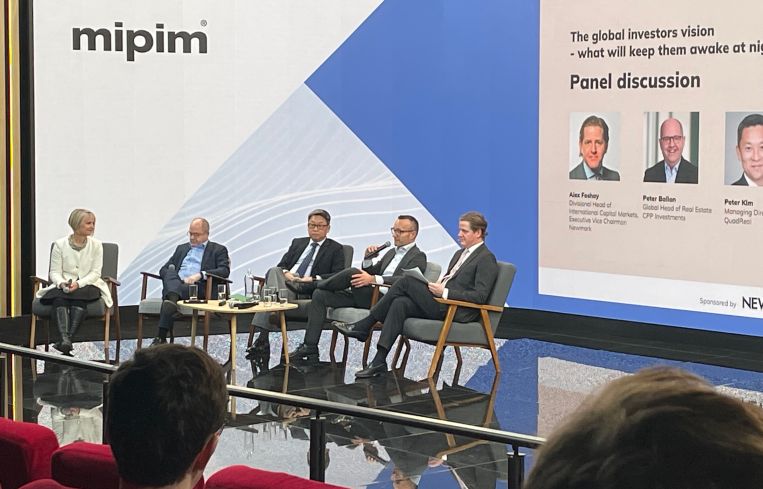Commercial Real Estate at ‘Start of the Healing Process’: MIPIM Panelists
By Nicholas Rizzi March 12, 2024 1:25 pm
reprints
Investors have seen a lot of the same issues impacting the commercial real estate market in the United States playing out in other parts of the globe: high inflation leading to elevated interest rates, and increased hybrid work emptying office buildings.
That has led to a pullback of institutional investors worldwide. However, with the Federal Reserve indicating it will cut rates this year, and other central banks expected to follow suit, there’s hope in the market.
“What we’re seeing is the start of the healing process,” Alex Foshay, head of international capital markets at Newmark, said Tuesday during a panel at the MIPIM convention in Cannes, France. “Now is the time to be optimistic.”
And Foshay wasn’t alone in his take. Others on the “The Global Investors Vision — What Will Keep Them Awake at Night?” panel agreed there’s plenty of hope in the CRE market for 2024.
“Now is one of the best times to be deploying money,” said Alek Misev, head of property for Australian retirement fund Aware Super. “There’s not a lot of money out there, but there’s going to be a lot of opportunity coming to investors who have money to unlock value.”
Part of the reason for the opportunity is that there’s simply “less competition” in the market, said Peter Ballon, the global head of real estate for Canadian pension fund CPP Investments.
The competition out in the market now mainly has been Middle Eastern oil money and high-net-worth family offices that don’t need to worry about quick returns to investors, panelists said. That’s changing, though, as institutional investors start to return.
“We’ve seen, anecdotally, an increase of urgency amongst family offices who’ve sort of had the run of the field,” Foshay said. “They now realize that if they’re going to make more acquisitions that the next four to six months is the time to do it.”
The asset classes that have been targeted recently mainly include industrial, multifamily and retail properties, the latter of which has started to recover after coming out of a so-called “retail apocalypse” that was felt across the world.
The office market is still considered to be challenged, and many of the global investors on the panel said they weren’t particularly keen to drop dollars on most office buildings.
“As a sector, I do think the [office] sector is in trouble,” Ballon said. “Not everything bounces back.
“In terms of which sectors to invest in, I would put office closer to the bottom, if not at the bottom,” Ballon said.
While that’s true in much of the world, one region has been an outlier: Asia-Pacific. Aside from China, most office buildings in that part of the world still have low vacancy rates, and office has been “one of the best-performing asset classes in Korea,” said Peter Kim, managing director for Canadian investment firm QuadReal. And there are opportunities there too.
“There’s very little distress in Asia at the moment,” Kim said. “What we’re seeing is more of a pullback from the traditional banks and lenders, particularly from construction financing. … I think the real opportunity as a primary lender is to take advantage of the vacuum created by banks pulling back.”
However, at least in the United States, there has been more interest in the right office property. Foshay said that an office building up for sale now might draw 80 tours of interested buyers whereas Newmark might’ve only arranged 10 last year.
“This is a space where, initially, we expect to see the private equity groups coming in,” he said.
Nicholas Rizzi can be reached at nrizzi@commercialobserver.com.



